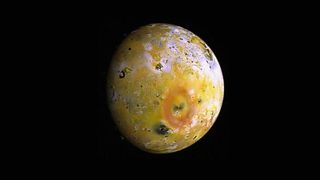At this time, we all know of greater than 5,000 exoplanets: planets outdoors our photo voltaic system that orbit different stars. Whereas the hassle to find new worlds goes on, we’re steadily studying extra concerning the exoplanets we’ve already detected: their sizes, what they’re fabricated from and whether or not they have atmospheres.
Our workforce has now supplied tentative proof for a sulphur-rich ambiance on a world that’s 1.5 occasions the dimension of Earth and positioned 35 gentle years away. If confirmed, it might be the smallest recognized exoplanet with an environment. The potential presence of the gases sulphur dioxide (SO₂) and hydrogen sulphide (H₂S) on this ambiance trace at a molten or volcanic floor.
In our photo voltaic system, we now have two distinct classes of planets – the small rocky ones, together with Earth and Mars, and the gasoline giants corresponding to Jupiter and Saturn. Nonetheless, exoplanets span a terrific spectrum of sizes. Our photo voltaic system lacks a planet whose dimension falls into the vary between Earth and Neptune, but it surely seems that’s the most typical sort of planet we now have seen round different stars in our galaxy.
Those nearer to Neptune’s dimension are referred to as sub-Neptunes and those nearer to Earth’s dimension are referred to as super-Earths. L 98-59 d is a super-Earth, barely greater and heavier than the Earth. The composition of the atmospheres of those planets continues to be an open query, one which we’re solely beginning to discover with the James Webb House Telescope (JWST), launched in 2021.
Associated: Close by exoplanet is a 1st-of-its-kind ‘steam world,’ James Webb House Telescope finds
L 98-59 d was found in 2019 with Nasa’s Tess area telescope. Most exoplanets, together with L 98-59 d, have been detected utilizing the “transit methodology”. This measures the tiny dips in starlight when the planet passes in entrance of the star. This dip is extra pronounced for bigger planets and allows us to determine the scale of a planet.
Even JWST can’t separate these tiny planets from their host stars – as they orbit their stars too carefully. However there’s a strategy to “see” the planet’s ambiance from this entangled gentle. When a planet passes in entrance of its star, a few of the starlight filters via a planet’s ambiance, hitting the gasoline molecules or atoms current there, on its strategy to us on Earth.
Each gasoline modifies the sunshine in its personal signature method. From the sunshine we obtain from that star system, we are able to infer what the composition of that ambiance is likely to be. That is referred to as transmission spectroscopy, a confirmed method that has beforehand been used to verify the presence of CO₂ in an exoplanet’s ambiance.
I’m a part of a world workforce of scientists who used JWST to look at one transit of L 98-59 d throughout the disc of its host star. We then obtained the transmission spectrum of the ambiance of the exoplanet from these observations. This spectrum hinted on the doable presence of an ambiance crammed with sulphur dioxide and hydrogen sulphide.
This discovery was shocking, because it stands out in stark distinction to the atmospheres of rocky planets in our personal photo voltaic system, the place water vapour and carbon dioxide are way more prevalent. Earth’s ambiance, for instance, is wealthy in nitrogen and oxygen, with hint quantities of water vapour. In the meantime, Venus has a thick ambiance dominated by carbon dioxide. Even Mars has a skinny ambiance dominated by carbon dioxide.
We then used pc fashions that incorporate our understanding of planetary atmospheres and the sunshine coming from L 98-59 d to provide you with a possible image of the composition of this planet’s ambiance. The absence of frequent gases corresponding to carbon dioxide and the presence of SO₂ and H₂S suggests an environment formed by solely totally different processes to these we’re acquainted with in our photo voltaic system. This hints at distinctive and excessive situations on L 98-59 d, corresponding to a molten or volcanic floor.
Further observations shall be mandatory to verify the presence of those gases. JWST observations had beforehand noticed indicators of SO₂ on an exoplanet, however this was a gasoline large, not a probably rocky world corresponding to L 98-59 d.

Exo-volcanoes?
The potential presence of SO₂ and H₂S raises questions on their origin. One explosive chance is volcanism pushed by tidal heating, very like what’s noticed on Jupiter’s moon Io. The gravitational pull of the host star on this planet stretches and squeezes it because it goes alongside its orbit. This movement can warmth up the centre of the planet, melting its interiors and producing excessive volcanic eruptions and presumably even oceans of magma.
Mixed with its shut proximity to the star (one yr on this planet is seven and half Earth days), really hellish temperatures may be reached on the floor. If future observations help the presence of such an environment, not solely wouldn’t it be the smallest exoplanet to have a detected ambiance, but additionally a vital step in the direction of understanding the character of such planets.
Detecting atmospheres on small, rocky planets is exceptionally troublesome, because the planets are very small in comparison with the host stars, and in addition as intense radiation from their host stars usually strips the atmospheres away. These observations, whereas tantalizing, are solely from a single transit. Which means instrumental noise and different elements stop us from making statistically robust claims. Future JWST observations shall be key in confirming or refuting our evaluation.
L 98-59 d will not be a candidate for all times as we all know it, however finding out its sulphurous ambiance and potential volcanism supplies invaluable perception into worlds round different stars. Excessive worlds like these assist us perceive the range of planetary evolution throughout the galaxy.





